A Review of Multifunctional Antenna Designs for Internet of Things
Abstract
:1. Introduction
2. Materials and Methods
2.1. Biomedical Devices
- The Tongue Drive System (TDS), which allows for control of devices through tongue movements [22];
- Leadless pacemakers that provide cardiac rhythm management without the need for wired leads [23];
- Neurostimulators that deliver electrical stimulation to targeted areas of the brain or nervous system [24];
- Techniques for imaging blood vessels to support diagnosis and treatment planning [25];
- Drug delivery systems designed to release medications in a controlled manner at targeted locations within the body [26].
2.1.1. Challenges of Ingestible and Implantable Antennas
2.1.2. Planar Loop Antennas
2.1.3. Meander Antennas
2.1.4. Various Antenna Types
2.1.5. Magnetoelectric Antennas
2.1.6. Discussions and Perspectives through Interdisciplinary Collaborations
2.2. Smart Home Appliances
2.2.1. Antenna Specifications
2.2.2. Characteristic Mode Analysis as IoT Design Tool
2.2.3. Alternative Methods for Agile Antennas
2.2.4. Recent Feedback on Smart Homes
2.3. Smart Cities
2.3.1. Challenges for Next-Generation Smart City Antennas
- Most antennas and feeding networks suffer from narrow band response, limiting the applications.
- In uniform arrays, the distance of the elements (d) limits the operation bandwidth due to beam squint ().
- To efficiently steer the beam in space (3D) huge planar arrays are normally needed, which significantly increases the size and the complexity (feeding network) of the system.
- To adaptively steer an antenna demands huge computational resources (usually incorporating a microprocessor in the device), making it more power hungry while increasing latency.
- Off-the-shelf electronically tunable elements (e.g., phase shifter) are limited in the market and when they are found their tunability is small.
- All-polarization arrays are difficult to develop due to the complexity of the array’s elements and feeding network.
2.3.2. State-of-the-Art Compact Antennas
- A fan-shaped patch antenna system capable of producing four end-fire beams [104];
- A 14-beam slot-based cylindrical cavity antenna, which exemplifies the use of ESPARs in more complex configurations, offering a higher number of beam directions for enhanced coverage and flexibility [108];
- A 12-beam metasurface-based antenna, complemented by a reflector made of an artificial magnetic conductor reflector [107].
2.3.3. Necessity of Integrated Social–Technical Systems—Smart Cities
3. Conclusions
Author Contributions
Funding
Data Availability Statement
Conflicts of Interest
References
- Bahalul Haque, A.K.M.; Oahiduzzaman Mondol Zihad, M.; Rifat Hasan, M. 5G and Internet of Things—Integration Trends, Opportunities, and Future Research Avenues. In 5G and Beyond; Bhushan, B., Sharma, S.K., Kumar, R., Priyadarshini, I., Eds.; Springer Nature: Singapore, 2023; pp. 217–245. [Google Scholar] [CrossRef]
- Chan, R.; Yan, W.K.; Ma, J.M.; Loh, K.M.; Yu, T.; Low, M.Y.H.; Yar, K.P.; Rehman, H.; Phua, T.C. IoT devices deployment challenges and studies in building management system. Front. Internet Things 2023, 2, 1254160. [Google Scholar] [CrossRef]
- Roges, R.; Malik, P.K. Planar and printed antennas for Internet of Things-enabled environment: Opportunities and challenges. Int. J. Commun. Syst. 2021, 34, e4940. [Google Scholar] [CrossRef]
- Kiourti, A.; Nikita, K.S. A Review of In-Body Biotelemetry Devices: Implantables, Ingestibles, and Injectables. IEEE Trans. Biomed. Eng. 2017, 64, 1422–1430. [Google Scholar] [CrossRef] [PubMed]
- Dai, L.; Wang, B.; Ding, Z.; Wang, Z.; Chen, S.; Hanzo, L. A Survey of Non-Orthogonal Multiple Access for 5G. IEEE Commun. Surv. Tutorials 2018, 20, 2294–2323. [Google Scholar] [CrossRef]
- Li, K.; Shi, Y.; Shen, H.; Li, L. A Characteristic-Mode-Based Polarization-Reconfigurable Antenna and its Array. IEEE Access 2018, 6, 64587–64595. [Google Scholar] [CrossRef]
- Russo, N.E.; Zekios, C.L.; Georgakopoulos, S.V. A CMA-Based Electronically Reconfigurable Dual-Mode and Dual-Band Antenna. Electronics 2023, 12, 3915. [Google Scholar] [CrossRef]
- Tubbal, F.; Matekovits, L.; Raad, R. Antenna Designs for 5G/IoT and Space Applications. Electronics 2022, 11, 2484. [Google Scholar] [CrossRef]
- Alkurt, F.; Unal, E.; Palandoken, M.; Abdulkarim, Y.; Hasar, U.C.; Karaaslan, M. Radiation pattern reconfigurable cubical antenna array for 2.45 GHz wireless communication applications. Wirel. Netw. 2022, 29, 235–246. [Google Scholar] [CrossRef]
- Balanis, C.A. Antenna Theory: Analysis and Design; JOHN WILEY & SONS: Hoboken, NJ, USA, 2005. [Google Scholar]
- Huang, B.B.; Liu, N.W. A Low-Profile Circularly Polarized Antenna Array for Beam Steering. In Proceedings of the TENCON 2022—2022 IEEE Region 10 Conference (TENCON), Hong Kong, China, 1–4 November 2022; pp. 1–3. [Google Scholar] [CrossRef]
- Subbaraj, S.; Thomas, S.B. Reconfigurable Antennas and Their Practical Applications—A Review. Radio Sci. 2023, 58, e2023RS007656. [Google Scholar] [CrossRef]
- Kumar, S.; Dixit, A.S.; Malekar, R.R.; Raut, H.D.; Shevada, L.K. Fifth Generation Antennas: A Comprehensive Review of Design and Performance Enhancement Techniques. IEEE Access 2020, 8, 163568–163593. [Google Scholar] [CrossRef]
- Dahri, M.H.; Jamaluddin, M.H.; Abbasi, M.I.; Kamarudin, M.R. A Review of Wideband Reflectarray Antennas for 5G Communication Systems. IEEE Access 2017, 5, 17803–17815. [Google Scholar] [CrossRef]
- Alhamad, R.; Almajali, E.; Mahmoud, S. Electrical Reconfigurability in Modern 4G, 4G/5G and 5G Antennas: A Critical Review of Polarization and Frequency Reconfigurable Designs. IEEE Access 2023, 11, 29215–29233. [Google Scholar] [CrossRef]
- Kim, S.; Park, J.; So, S.; Ahn, S.; Choi, J.; Koo, C.; Joung, Y.H. Characteristics of an Implantable Blood Pressure Sensor Packaged by Ultrafast Laser Microwelding. Sensors 2019, 19, 1801. [Google Scholar] [CrossRef] [PubMed]
- Kaefer, K.; Krüger, K.; Schlapp, F.; Uzun, H.; Celiksoy, S.; Flietel, B.; Heimann, A.; Schroeder, T.; Kempski, O.; Sönnichsen, C. Implantable Sensors Based on Gold Nanoparticles for Continuous Long-Term Concentration Monitoring in the Body. Nano Lett. 2021, 21, 3325–3330. [Google Scholar] [CrossRef] [PubMed]
- Wang, H.; Feng, Y.; Guo, Y.X. Design of a Miniaturized Ingestible Antenna with Complex Input Impedance for Biotelemetry Applications. In Proceedings of the 2022 Asia-Pacific Microwave Conference (APMC), Yokohama, Japan, 29 November–2 December 2022; pp. 37–39. [Google Scholar] [CrossRef]
- Ma, S.; Björninen, T.; Sydänheimo, L.; Voutilainen, M.H.; Ukkonen, L. Double Split Rings as Extremely Small and Tuneable Antennas for Brain Implantable Wireless Medical Microsystems. IEEE Trans. Antennas Propag. 2021, 69, 760–768. [Google Scholar] [CrossRef]
- An, H.; Nason-Tomaszewski, S.R.; Lim, J.; Kwon, K.; Willsey, M.S.; Patil, P.G.; Kim, H.S.; Sylvester, D.; Chestek, C.A.; Blaauw, D. A Power-Efficient Brain-Machine Interface System with a Sub-mw Feature Extraction and Decoding ASIC Demonstrated in Nonhuman Primates. IEEE Trans. Biomed. Circuits Syst. 2022, 16, 395–408. [Google Scholar] [CrossRef] [PubMed]
- Mainul, E.A.; Hossain, M.F. Design of a Compact Implantable Antenna in Seven-layer Brain Phantom for Brain-machine Interface Applications. In Proceedings of the 2021 International Conference on Electronics, Communications and Information Technology (ICECIT), Khulna, Bangladesh, 14–16 September 2021; pp. 1–4. [Google Scholar] [CrossRef]
- Kong, F.; Zada, M.; Yoo, H.; Ghovanloo, M. Triple-Band Transmitter with a Shared Dual-Band Antenna and Adaptive Matching for an Intraoral Tongue Drive System. In Proceedings of the 2018 IEEE International Symposium on Circuits and Systems (ISCAS), Florence, Italy, 27–30 May 2018; pp. 1–5. [Google Scholar] [CrossRef]
- Faisal, F.; Zada, M.; Yoo, H.; Mabrouk, I.B.; Chaker, M.; Djerafi, T. An Ultra-Miniaturized Antenna with Ultra-Wide Bandwidth for Future Cardiac Leadless Pacemaker. IEEE Trans. Antennas Propag. 2022, 70, 5923–5928. [Google Scholar] [CrossRef]
- Feng, Y.; Li, Y.; Li, L.; Ma, B.; Hao, H.; Li, L. Tissue-Dependent Co-Matching Method for Dual-Mode Antenna in Implantable Neurostimulators. IEEE Trans. Antennas Propag. 2019, 67, 5253–5264. [Google Scholar] [CrossRef]
- Ullah, S.; Yoo, H. High-Resolution Implantable Microcoil Antennas for Blood-Vessel Imaging in High-Field MRIs. IEEE Trans. Antennas Propag. 2021, 69, 2560–2570. [Google Scholar] [CrossRef]
- Khan, A.N.; Wen, D.; Liu, Y.; Sukhorukov, G.; Hao, Y. An Ultrawideband Conformal Antenna for Implantable Drug Delivery Device. In Proceedings of the 2020 14th European Conference on Antennas and Propagation (EuCAP), Copenhagen, Denmark, 15–20 March 2020; pp. 1–3. [Google Scholar] [CrossRef]
- Gabriel, C.; Gabriel, S. Compilation of the Dielectric Properties of Body Tissues at RF and Microwave Frequencies; Internet Document. 1996. Available online: http://safeemf.iroe.fi.cnr.it (accessed on 8 August 2024).
- Panunzio, N.; Ligresti, G.; Losardo, M.; Masi, D.; Mostaccio, A.; Nanni, F.; Tartaglia, G.; Marrocco, G. Cyber-Tooth: Antennified Dental Implant for RFID Wireless Temperature Monitoring. In Proceedings of the 2021 IEEE International Conference on RFID Technology and Applications (RFID-TA), Delhi, India, 6–8 October 2021; pp. 211–214. [Google Scholar] [CrossRef]
- Nikolayev, D.; Skrivervik, A.K.; Ho, J.S.; Zhadobov, M.; Sauleau, R. Reconfigurable Dual-Band Capsule-Conformal Antenna Array for In-Body Bioelectronics. IEEE Trans. Antennas Propag. 2022, 70, 3749–3761. [Google Scholar] [CrossRef]
- Wang, Y.; Yan, S.; Huang, B. Conformal Folded Inverted-F Antenna with Quasi-Isotropic Radiation Pattern for Robust Communication in Capsule Endoscopy Applications. IEEE Trans. Antennas Propag. 2022, 70, 6537–6550. [Google Scholar] [CrossRef]
- Basir, A.; Cho, Y.; Shah, I.A.; Hayat, S.; Ullah, S.; Zada, M.; Shah, S.A.A.; Yoo, H. Implantable and Ingestible Antenna Systems: From imagination to realization [Bioelectromagnetics]. IEEE Antennas Propag. Mag. 2023, 65, 70–83. [Google Scholar] [CrossRef]
- Yousaf, M.; Mabrouk, I.B.; Faisal, F.; Zada, M.; Bashir, Z.; Akram, A.; Nedil, M.; Yoo, H. Compacted Conformal Implantable Antenna with Multitasking Capabilities for Ingestible Capsule Endoscope. IEEE Access 2020, 8, 157617–157627. [Google Scholar] [CrossRef]
- Basir, A.; Yoo, H. A Quadband Implantable Antenna System for Simultaneous Wireless Powering and Biotelemetry of Deep-Body Implants. In Proceedings of the 2020 IEEE/MTT-S International Microwave Symposium (IMS), Los Angeles, CA, USA, 4–6 August 2020; pp. 496–499. [Google Scholar] [CrossRef]
- Janapala, D.K.; Moses, N.; Bhagavathsingh, J. Compact size antenna for skin implantable medical devices. Int. J. Microw. Wirel. Technol. 2023, 1–10. [Google Scholar] [CrossRef]
- IEEE C95. 1-2019; IEEE Standard for Safety Levels with Respect to Human Exposure to Electric, Magnetic, and Electromagnetic Fields, 0 Hz to 300 GHz. BOG/ICES—International Committee on Electromagnetic Safety: New York, NY, USA, 2019; pp. 1–312. [CrossRef]
- Wang, H.; Feng, Y.; Guo, Y. A Differentially Fed Antenna with Complex Impedance for Ingestible Wireless Capsules. IEEE Antennas Wirel. Propag. Lett. 2022, 21, 139–143. [Google Scholar] [CrossRef]
- Zhang, J.; Das, R.; Hoare, D.; Wang, H.; Ofiare, A.; Mirzai, N.; Mercer, J.; Heidari, H. A Compact Dual-Band Implantable Antenna for Wireless Biotelemetry in Arteriovenous Grafts. IEEE Trans. Antennas Propag. 2023, 71, 4759–4771. [Google Scholar] [CrossRef]
- Pournoori, N.; Sydänheimo, L.; Rahmat-Samii, Y.; Ukkonen, L.; Björninen, T. Small Triple-Band Meandered PIFA for Brain-Implantable Biotelemetric Systems: Development and Testing in a Liquid Phantom. Int. J. Antennas Propag. 2021, 2021, 6035169. [Google Scholar] [CrossRef]
- Kumar, R.; Singh, S.; Singh Chauhan, A.P. Multiband antenna design based on Gosper fractal for implantable biomedical devices. Int. J. Microw. Wirel. Technol. 2022, 14, 970–980. [Google Scholar] [CrossRef]
- Shanmughavel, S.; Sona, S. Design of PET Substrate Based Independently Controllable Triangular DRA for Implantable Devices. In Proceedings of the 2023 International Conference on Emerging Research in Computational Science (ICERCS), Coimbatore, India, 7–9 December 2023; pp. 1–4. [Google Scholar] [CrossRef]
- Shaw, T.; Mandal, B.; Mitra, D.; Rangaiah, P.K.; Perez, M.D.; Augustine, R. Metamaterial integrated highly efficient wireless power transfer system for implantable medical devices. AEU-Int. J. Electron. Commun. 2024, 173, 155010. [Google Scholar] [CrossRef]
- Sapari, L.; Hout, S.; Chung, J.Y. Brain Implantable End-Fire Antenna with Enhanced Gain and Bandwidth. Sensors 2022, 22, 4328. [Google Scholar] [CrossRef] [PubMed]
- Cui, Y.; Wang, C.; Song, X.; Wu, M.; Zhang, Q.; Yuan, H.; Yuan, Z. A survey of mechanical antennas applied for low-frequency transmitting. iScience 2023, 26, 105832. [Google Scholar] [CrossRef] [PubMed]
- Das, D.; Xu, Z.; Nasrollahpour, M.; Martos-Repath, I.; Zaeimbashi, M.; Khalifa, A.; Mittal, A.; Cash, S.S.; Sun, N.X.; Shrivastava, A.; et al. Circuit-Level Modeling and Simulation of Wireless Sensing and Energy Harvesting with Hybrid Magnetoelectric Antennas for Implantable Neural Devices. IEEE Open J. Circuits Syst. 2023, 4, 139–155. [Google Scholar] [CrossRef] [PubMed]
- Hassanien, A.E.; Breen, M.; Li, M.H.; Gong, S. A theoretical study of acoustically driven antennas. J. Appl. Phys. 2020, 127, 014903. [Google Scholar] [CrossRef]
- Mukherjee, D.; Mallick, D. A self-biased, low-frequency, miniaturized magnetoelectric antenna for implantable medical device applications. Appl. Phys. Lett. 2023, 122, 014102. [Google Scholar] [CrossRef]
- Hosur, S.; Karan, S.K.; Priya, S.; Kiani, M. Short-Range Communication for Small Biomedical Implants using Magnetoelectric Effect. In Proceedings of the 2023 IEEE International Symposium on Circuits and Systems (ISCAS), Monterey, CA, USA, 21–25 May 2023; pp. 1–5. [Google Scholar] [CrossRef]
- Nunez, P.; Srinivasan, R. A theoretical basis for standing and traveling brain waves measured with human EEG with implications for an integrated consciousness. Clin. Neurophysiol. Off. J. Int. Fed. Clin. Neurophysiol. 2006, 117, 2424–2435. [Google Scholar] [CrossRef] [PubMed]
- Yao, Z.; Wang, Y.E.; Keller, S.; Carman, G.P. Bulk Acoustic Wave-Mediated Multiferroic Antennas: Architecture and Performance Bound. IEEE Trans. Antennas Propag. 2015, 63, 3335–3344. [Google Scholar] [CrossRef]
- Nan, T.; Lin, H.; Gao, Y.; Matyushov, A.; Yu, G.; Chen, H.; Sun, N.; Wei, S.; Wang, Z.; Li, M.; et al. Acoustically actuated ultra-compact NEMS magnetoelectric antennas. Nat. Commun. 2017, 8, 296. [Google Scholar] [CrossRef] [PubMed]
- Li, N.; Li, X.; Xu, B.; Zheng, B.; Zhao, P. Design and Optimization of a Micron-Scale Magnetoelectric Antenna Based on Acoustic Excitation. Micromachines 2022, 13, 1584. [Google Scholar] [CrossRef] [PubMed]
- Lodi, M.B.; Makridis, A.; Kazeli, K.; Samaras, T.; Angelakeris, M.; Muntoni, G.; Fanti, A.; Mazzarella, G. A methodology for the measurement of the specific absorption rate of magnetic scaffolds. In Proceedings of the 2023 24th International Conference on Applied Electromagnetics and Communications (ICECOM), Dubrovnik, Croatia, 27–29 September 2023; pp. 1–4. [Google Scholar] [CrossRef]
- MIT. MIT White Papers. Available online: https://connection.mit.edu/white-papers (accessed on 27 July 2024).
- Chakraborty, A.; Islam, M.; Shahriyar, F.; Islam, S.; Zaman, H.; Hasan, M. Smart Home System: A Comprehensive Review. J. Electr. Comput. Eng. 2023, 2023, 7616683. [Google Scholar] [CrossRef]
- Athanasiadis, C.L.; Pippi, K.D.; Papadopoulos, T.A.; Korkas, C.; Tsaknakis, C.; Alexopoulou, V.; Nikolaidis, V.; Kosmatopoulos, E. A Smart Energy Management System for Elderly Households. In Proceedings of the 2022 57th International Universities Power Engineering Conference (UPEC), Istanbul, Turkey, 30 August–2 September 2022; pp. 1–6. [Google Scholar] [CrossRef]
- Arnaoutoglou, D.G.; Kyriakou, A.A.G.; Kaifas, T.N.F.; Sirakoulis, G.C.; Kyriacou, G.A. An All-Polarization, Beamforming, and DoA Ready, Γ–Dipole Antenna Array. IEEE Trans. Antennas Propag. 2024, 72, 2323–2336. [Google Scholar] [CrossRef]
- Mazaheri, M.; Ruiz, R.; Giustiniano, D.; Widmer, J.; Abari, O. Bringing Millimeter Wave Technology to Any IoT Device. In Proceedings of the 29th Annual International Conference on Mobile Computing and Networking, 2–6 October 2023; Association for Computing Machinery: New York, NY, USA, 2023. [Google Scholar]
- Hu, R.; Lin, W.; Yun, X.; Xu, D.; Zhang, B.; Zeng, Z. A High-Gain Ultra-Compact ME Antenna Design for Portable RF Wireless Communication. In Proceedings of the 2022 IEEE 9th International Symposium on Microwave, Antenna, Propagation and EMC Technologies for Wireless Communications (MAPE), Chengdu, China, 26–29 August 2022; pp. 165–168. [Google Scholar] [CrossRef]
- Vaquero, Á.F.; Teixeira, J.; Matos, S.A.; Arrebola, M.; Costa, J.R.; Felício, J.M.; Fernandes, C.A.; Fonseca, N.J.G. Design of Low-Profile Transmitarray Antennas with Wide Mechanical Beam Steering at Millimeter Waves. IEEE Trans. Antennas Propag. 2023, 71, 3713–3718. [Google Scholar] [CrossRef]
- Wang, C.; Yeo, J.C.; Chu, H.; Lim, C.T.; Guo, Y.X. Design of a Reconfigurable Patch Antenna Using the Movement of Liquid Metal. IEEE Antennas Wirel. Propag. Lett. 2018, 17, 974–977. [Google Scholar] [CrossRef]
- Selvam, Y.P.; Sangamithira, N.; Karuppasamy, T.; Puvvadi, M.; Jayapalan, A. Optically Reconfigurable Slotted Waveguide Antenna Array for 5G Applications. In Proceedings of the 2023 International Conference on Computer Communication and Informatics (ICCCI), Coimbatore, India, 23–25 January 2023; pp. 1–4. [Google Scholar] [CrossRef]
- Elias, B.B.Q.; Soh, P.J.; Al-Hadi, A.A.; Akkaraekthalin, P.; Vandenbosch, G.A.E. A Review of Antenna Analysis Using Characteristic Modes. IEEE Access 2021, 9, 98833–98862. [Google Scholar] [CrossRef]
- Huang, H.; Wen, H. Miniaturized reconfigurable tri-polarization metantenna based on characteristic mode analysis with high-aperture efficiency. Int. J. RF Microw. Comput.-Aided Eng. 2021, 31, e22867. [Google Scholar] [CrossRef]
- Molins-Benlliure, J.; Antonino-Daviu, E.; Cabedo-Fabrés, M.; Ferrando-Bataller, M. Design Procedure for 5G/IoT Multiple-Port Cavity-Backed Antennas. In Proceedings of the 2021 15th European Conference on Antennas and Propagation (EuCAP), Dusseldorf, Germany, 22–26 March 2021; pp. 1–5. [Google Scholar] [CrossRef]
- SR, V.K.; Venkatesh, T.; Rajanna, P.K.T. Characteristic Mode Analysis of Polarization Reconfigurable Compact Metasurface Antenna for sub-6GHz 5G Application. In Proceedings of the 2023 3rd International Conference on Mobile Networks and Wireless Communications (ICMNWC), Tumkur, India, 4–5 December 2023; pp. 1–6. [Google Scholar] [CrossRef]
- Tran, H.H.; Park, H.C. Wideband Reconfigurable Antenna with Simple Biasing Circuit and Tri-Polarization Diversity. IEEE Antennas Wirel. Propag. Lett. 2019, 18, 2001–2005. [Google Scholar] [CrossRef]
- Kiani, H.; Chatzichristodoulou, D.; Nadeem, A.; Quddious, A.; Shoaib, N.; Vryonides, P.; Anagnostou, D.E.; Nikolaou, S. Microfluidically Frequency & Polarization Reconfigurable Patch Antennas. In Proceedings of the 2022 16th European Conference on Antennas and Propagation (EuCAP), Madrid, Spain, 27 March–1 April 2022; pp. 1–5. [Google Scholar] [CrossRef]
- Kim, J.H.; Joo, C.H.; Ahn, S.H.; Lee, W.S. A quadruple-polarized reconfigurable antenna for 915 MHz ISM band applications. In Proceedings of the 2018 IEEE International Conference on Consumer Electronics (ICCE), Las Vegas, NV, USA, 12–14 January 2018; pp. 1–2. [Google Scholar] [CrossRef]
- Dong, H.J.; Kim, Y.B.; Lee, H.L. Reconfigurable Quad-Polarization Switched Beamforming Antenna with Crossed Inverted-V Array and Dual-Butler Matrix. IEEE Trans. Antennas Propag. 2022, 70, 2708–2716. [Google Scholar] [CrossRef]
- Liu, M.; Zhai, Z.J.; Lin, F.; Sun, H.J. Wideband Quad-Polarization-Reconfigurable Bidirectional Antenna with a Simple Wideband Switchable Feeding Network. IEEE Antennas Wirel. Propag. Lett. 2023, 22, 1346–1350. [Google Scholar] [CrossRef]
- Row, J.S.; Wei, Y.H. Wideband Reconfigurable Crossed-Dipole Antenna with Quad-Polarization Diversity. IEEE Trans. Antennas Propag. 2018, 66, 2090–2094. [Google Scholar] [CrossRef]
- Takato, S.; Arai, H.; Moon, Y.C.; Kim, D.Y. Decoupling Design of Quad-Polarization Overlay Antenna Element with a Stacked Structure. IEEE Antennas Wirel. Propag. Lett. 2023, 22, 1336–1340. [Google Scholar] [CrossRef]
- Zhao, W.; Li, X.; Qi, Z.; Zhu, H. High-Order-Mode Cavity Fed Antenna Arrays for Diverse Polarizations with Compact Size, High Gain, and High Efficiency. IEEE Trans. Antennas Propag. 2022, 70, 1045–1056. [Google Scholar] [CrossRef]
- Chen, S.L.; Liu, Y.; Zhu, H.; Chen, D.; Guo, Y.J. Millimeter-Wave Cavity-Backed Multi-Linear Polarization Reconfigurable Antenna. IEEE Trans. Antennas Propag. 2022, 70, 2531–2542. [Google Scholar] [CrossRef]
- Tran, H.H.; Nguyen-Trong, N.; Le, T.T.; Park, H.C. Wideband and Multipolarization Reconfigurable Crossed Bowtie Dipole Antenna. IEEE Trans. Antennas Propag. 2017, 65, 6968–6975. [Google Scholar] [CrossRef]
- Guo, P.; Zhong, W.; Chen, S.L.; Chen, D.; Liu, Y. A Novel Programmable Stacked Patch Antenna with the Diversity of Sixteen Linear Polarizations and Four Frequency Bands. IEEE Trans. Antennas Propag. 2023, 71, 1035–1040. [Google Scholar] [CrossRef]
- Wang, S.; Yang, D.; Geyi, W.; Zhao, C.; Ding, G. Polarization-Reconfigurable Antenna Using Combination of Circular Polarized Modes. IEEE Access 2021, 9, 45622–45631. [Google Scholar] [CrossRef]
- Mohamed, I.M.; Sebak, A.R. 60 GHz 2-D Scanning Multibeam Cavity-Backed Patch Array Fed by Compact SIW Beamforming Network for 5G Applications. IEEE Trans. Antennas Propag. 2019, 67, 2320–2331. [Google Scholar] [CrossRef]
- Li, Q.; Hirokawa, J.; Tomura, T.; Takahashi, Y.; Kita, N.; Fonseca, N.J.G. A Two-Dimensional 6×4-Way Hollow Waveguide Beam-Switching Matrix. IEEE Access 2023, 11, 74239–74249. [Google Scholar] [CrossRef]
- Zhu, H.; Peng, J.; Gao, C.; Qian, Z. A Two-Dimensional Beam Scanning 60 GHz Antenna Array Based on SIW Butler Matrix. In Proceedings of the 2023 Cross Strait Radio Science and Wireless Technology Conference (CSRSWTC), Guilin, China, 10–13 November 2023; pp. 1–3. [Google Scholar] [CrossRef]
- Li, Q.; Hirokawa, J.; Tomura, T.; Fonseca, N.J.G. Two-Dimensional One-Body 3 × 3-Way Hollow-Waveguide Nolen Matrix Using a Two-Plane Unequal Division Coupler. IEEE Trans. Microw. Theory Tech. 2024, 72, 376–390. [Google Scholar] [CrossRef]
- Wang, D.; Xu, K.D.; Cao, Y.; Guo, C.; Yan, S. A Butler Matrix-Based Multibeam W-Band Slot Antenna Array Fabricated by Metal Additive Manufacturing Technology. IEEE Trans. Antennas Propag. 2024, 72, 5349–5354. [Google Scholar] [CrossRef]
- Ji, L.Y.; Guo, Y.J.; Qin, P.Y.; Gong, S.X.; Mittra, R. A Reconfigurable Partially Reflective Surface (PRS) Antenna for Beam Steering. IEEE Trans. Antennas Propag. 2015, 63, 2387–2395. [Google Scholar] [CrossRef]
- Dutta, R.K.; Jaiswal, R.K.; Saikia, M.; Srivastava, K.V. Beam-Forming Antenna Based on Electrically Reconfigurable Frequency Selective Surface. In Proceedings of the 2022 IEEE Microwaves, Antennas, and Propagation Conference (MAPCON), Bangalore, India, 12–16 December 2022; pp. 511–515. [Google Scholar] [CrossRef]
- Ali, H. Spherical Active Frequency-Selective Surface for 3-D Beam-Scanning Antenna. In Proceedings of the 2024 18th European Conference on Antennas and Propagation (EuCAP), Glasgow, UK, 17–22 March 2024; pp. 1–4. [Google Scholar] [CrossRef]
- Chen, Y.; Chernogor, L.F.; Zheng, Y.; Jin, Z.; Sun, Z.; Yao, Z.; Wang, C.; Liu, T. Dual-Band Dual-Polarized Antenna Based on TDLS Metasurface for 4G/5G Base Station Applications. IEEE Trans. Circuits Syst. II Express Briefs 2024, 71, 577–581. [Google Scholar] [CrossRef]
- Vinod, G.V.; Khairnar, V.V. A Wideband Beam Steering and Beamwidth Reconfigurable Antenna Using Coding Metasurface. IEEE Access 2024, 12, 97143–97153. [Google Scholar] [CrossRef]
- Raza, M.U.; Zhang, Z.; Liu, T.; Shoukat, M.U.; Niaz, A.; Luo, K. Flexible Monopole Antenna for IoT Applications: A Survey. In Proceedings of the 2021 7th International Conference on Computer and Communications (ICCC), Chengdu, China, 10–13 December 2021; pp. 2154–2159. [Google Scholar] [CrossRef]
- Bhardwaj, S.; Malik, P.; Islam, T.; Gehlot, A.; Das, S.; Asha, S. A Printed Monopole Antenna for Next Generation Internet of Things: Narrow-Band Internet of Things (NB-IoT). Prog. Electromagn. Res. C 2023, 138, 117–129. [Google Scholar] [CrossRef]
- Muzaffar, S.; Turab, D.; Zahid, M.; Amin, Y. Dual-Band UWB Monopole Antenna for IoT Applications. Eng. Proc. 2023, 46, 29. [Google Scholar] [CrossRef]
- Yahya, M.S.; Soeung, S.; Singh, N.S.S.; Yunusa, Z.; Chinda, F.E.; Rahim, S.K.A.; Musa, U.; Nor, N.B.M.; Sovuthy, C.; Abro, G.E.M. Triple-Band Reconfigurable Monopole Antenna for Long-Range IoT Applications. Sensors 2023, 23, 5359. [Google Scholar] [CrossRef] [PubMed]
- Li, J.; Huang, J.; He, H.; Wang, Y. An Ultra-Thin Multi-Band Logo Antenna for Internet of Vehicles Applications. Electronics 2024, 13, 2792. [Google Scholar] [CrossRef]
- Gracias, J.S.; Parnell, G.S.; Specking, E.; Pohl, E.A.; Buchanan, R. Smart Cities—A Structured Literature Review. Smart Cities 2023, 6, 1719–1743. [Google Scholar] [CrossRef]
- Singh, P.; Goswami, P.K.; Sharma, S.; Goswami, G. Frequency Reconfigurable Multiband Antenna for IoT Applications in WLAN, Wi-Max, and C-Band. Prog. Electromagn. Res. C 2020, 102, 149–162. [Google Scholar] [CrossRef]
- Syed, A.S.; Sierra-Sosa, D.; Kumar, A.; Elmaghraby, A. IoT in Smart Cities: A Survey of Technologies, Practices and Challenges. Smart Cities 2021, 4, 429–475. [Google Scholar] [CrossRef]
- Doré, J.B.; Belot, D.; Mercier, E.; Bicaïs, S.; Gougeon, G.; Corre, Y.; Miscopein, B.; Kténas, D.; Strinati, E.C. Technology Roadmap for Beyond 5G Wireless Connectivity in D-band. In Proceedings of the 2020 2nd 6G Wireless Summit (6G SUMMIT), Levi, Finland, 17–20 March 2020; pp. 1–5. [Google Scholar] [CrossRef]
- Kim, H.; Kim, J.; Oh, J. Communication A Novel Systematic Design of High-Aperture-Efficiency 2D Beam-Scanning Liquid-Crystal Embedded Reflectarray Antenna for 6G FR3 and Radar Applications. IEEE Trans. Antennas Propag. 2022, 70, 11194–11198. [Google Scholar] [CrossRef]
- Empliouk, T.; Kapetanidis, P.; Arnaoutoglou, D.; Kolitsidas, C.; Lialios, D.; Koutinos, A.; Kaifas, T.N.F.; Georgakopoulos, S.V.; Zekios, C.L.; Kyriacou, G.A. Compact, Ultra-Wideband Butler Matrix Beamformers for the Advanced 5G Band FR3—Part I. Electronics 2024, 13, 2763. [Google Scholar] [CrossRef]
- NYBSYS. Low to High 5G Bands Explained. Available online: https://nybsys.com/5g-bands/ (accessed on 27 July 2024).
- Chaloun, T.; Boccia, L.; Arnieri, E.; Fischer, M.; Valenta, V.; Fonseca, N.J.G.; Waldschmidt, C. Electronically Steerable Antennas for Future Heterogeneous Communication Networks: Review and Perspectives. IEEE J. Microwaves 2022, 2, 545–581. [Google Scholar] [CrossRef]
- Liu, T.Y.; Row, J.S. A scanning phased array based on a polarization reconfigurable antenna with compact aperture size. Int. J. RF Microw. Comput.-Aided Eng. 2021, 31, e22902. [Google Scholar] [CrossRef]
- Kim, B.; Park, J.; Choi, D.; Hong, W. A Software-Defined Reconfigurable Phased-Array Architecture for Beyond 5G Applications. In Proceedings of the 2021 International Conference on Microwave and Millimeter Wave Technology (ICMMT), Nanjing, China, 23–26 May 2021; pp. 1–3. [Google Scholar] [CrossRef]
- Hu, J.; Yang, X.; Ge, L.; Guo, Z.; Hao, Z.C.; Wong, H. A Reconfigurable 1 × 4 Circularly Polarized Patch Array Antenna with Frequency, Radiation Pattern, and Polarization Agility. IEEE Trans. Antennas Propag. 2021, 69, 5124–5129. [Google Scholar] [CrossRef]
- Santamaria, L.; Ferrero, F.; Staraj, R.; Lizzi, L. Electronically Pattern Reconfigurable Antenna for IoT Applications. IEEE Open J. Antennas Propag. 2021, 2, 546–554. [Google Scholar] [CrossRef]
- Wu, J.; Lu, X.; Wang, W.; Han, J.; Xu, G.; Huang, Z. Design of a Compact Polarization-Agile and Frequency-Tailored Array Antenna with Digital-Controllable Radiation Beams. IEEE Trans. Antennas Propag. 2022, 70, 813–822. [Google Scholar] [CrossRef]
- Chen, Q.; Ala-Laurinaho, J.; Khripkov, A.; Ilvonen, J.; Moreno, R.M.; Viikari, V. Varactor-Based Frequency-Reconfigurable Dual-Polarized mm-Wave Antenna Array for Mobile Devices. IEEE Trans. Antennas Propag. 2023, 71, 6628–6638. [Google Scholar] [CrossRef]
- Singh, V.; Khalily, M.; Tafazolli, R. A metasurface-based electronically steerable compact antenna system with reconfigurable artificial magnetic conductor reflector elements. iScience 2022, 25, 105549. [Google Scholar] [CrossRef] [PubMed]
- Santamaria, L.; Ferrero, F.; Staraj, R.; Lizzi, L. Slot-Based Pattern Reconfigurable ESPAR Antenna for IoT Applications. IEEE Trans. Antennas Propag. 2021, 69, 3635–3644. [Google Scholar] [CrossRef]
- Hasan, Z.; Gong, X. Design of A Reconfigurable-Polarization Slot-Ring Phased Array Antenna. In Proceedings of the 2023 IEEE International Symposium on Antennas and Propagation and USNC-URSI Radio Science Meeting (USNC-URSI), Portland, OR, USA, 23–28 July 2023; pp. 91–92. [Google Scholar] [CrossRef]
- Zandamela, A.; Marchetti, N.; Ammann, M.J.; Narbudowicz, A. Pattern and Polarization Diversity Multisector Annular Antenna for IoT Applications. IEEE Trans. Antennas Propag. 2023, 71, 7241–7249. [Google Scholar] [CrossRef]
- Palazzi, V.; Mezzanotte, P.; Roselli, L. A Novel Agile Phase-Controlled Beamforming Network Intended for 360° Angular Scanning in MIMO Applications. In Proceedings of the 2018 IEEE/MTT-S International Microwave Symposium—IMS, Philadelphia, PA, USA, 10–15 June 2018; pp. 624–627. [Google Scholar] [CrossRef]
- Wei, Z.; Zhu, X.; Chi, P.L.; Xu, R.; Yang, T. A Fully Reconfigurable 1 × 4 Filtering Beamforming Network with Continuous Phase and Amplitude Control. IEEE Trans. Microw. Theory Tech. 2024, 72, 348–362. [Google Scholar] [CrossRef]
- Wang, X.Z.; Chen, F.C.; Chu, Q.X. A Compact Broadband 4 × 4 Butler Matrix with 360° Continuous Progressive Phase Shift. IEEE Trans. Microw. Theory Tech. 2023, 71, 3906–3914. [Google Scholar] [CrossRef]
- Yu, D.; Liu, H.; Li, S.; Wang, Z.; Fang, S. Control-Relaxed Wideband 2 × 4 Nolen Matrix with 360° Continuously Tuned Differential Phase. IEEE Trans. Circuits Syst. II Express Briefs 2024, 71, 1979–1983. [Google Scholar] [CrossRef]







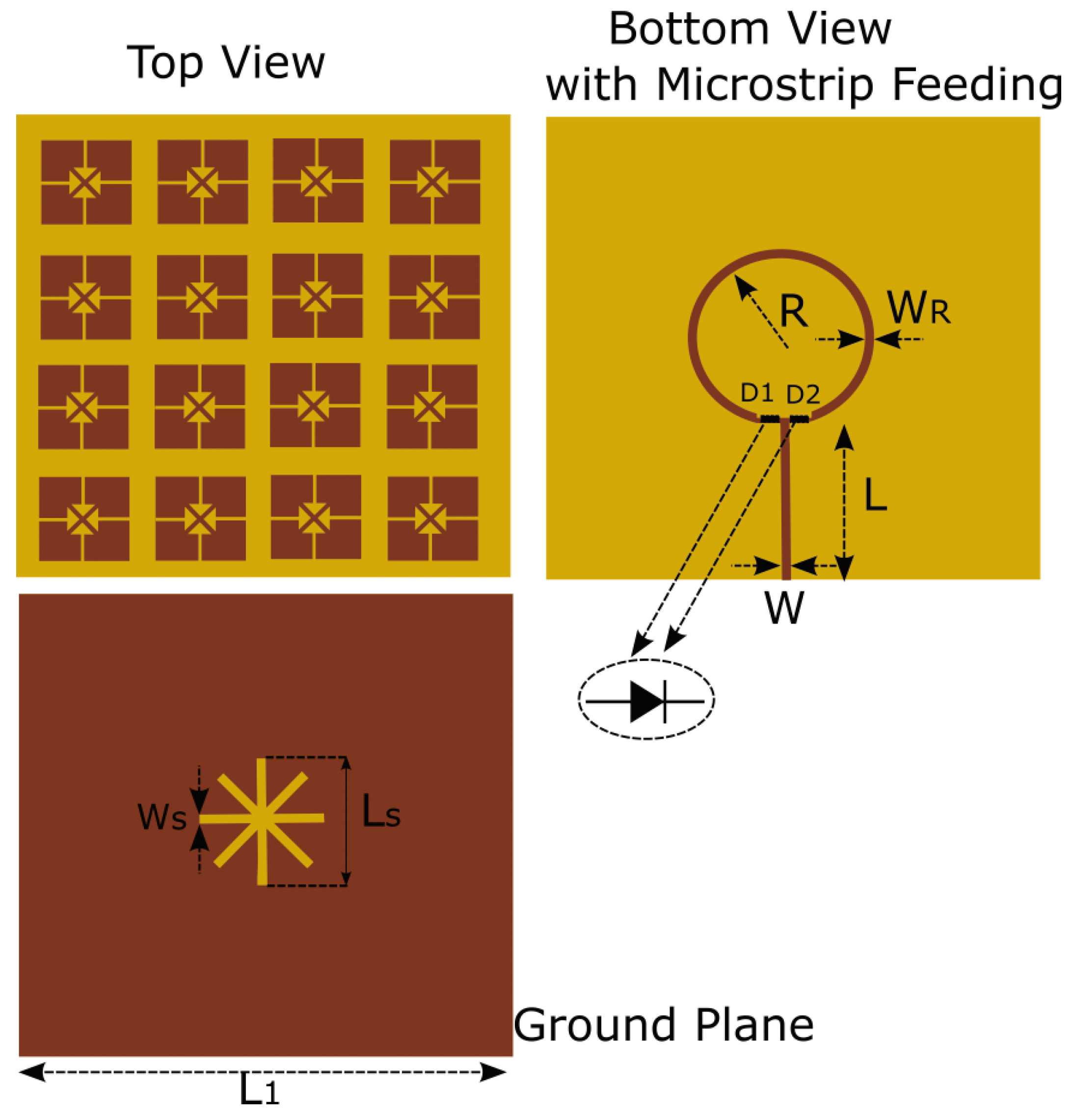
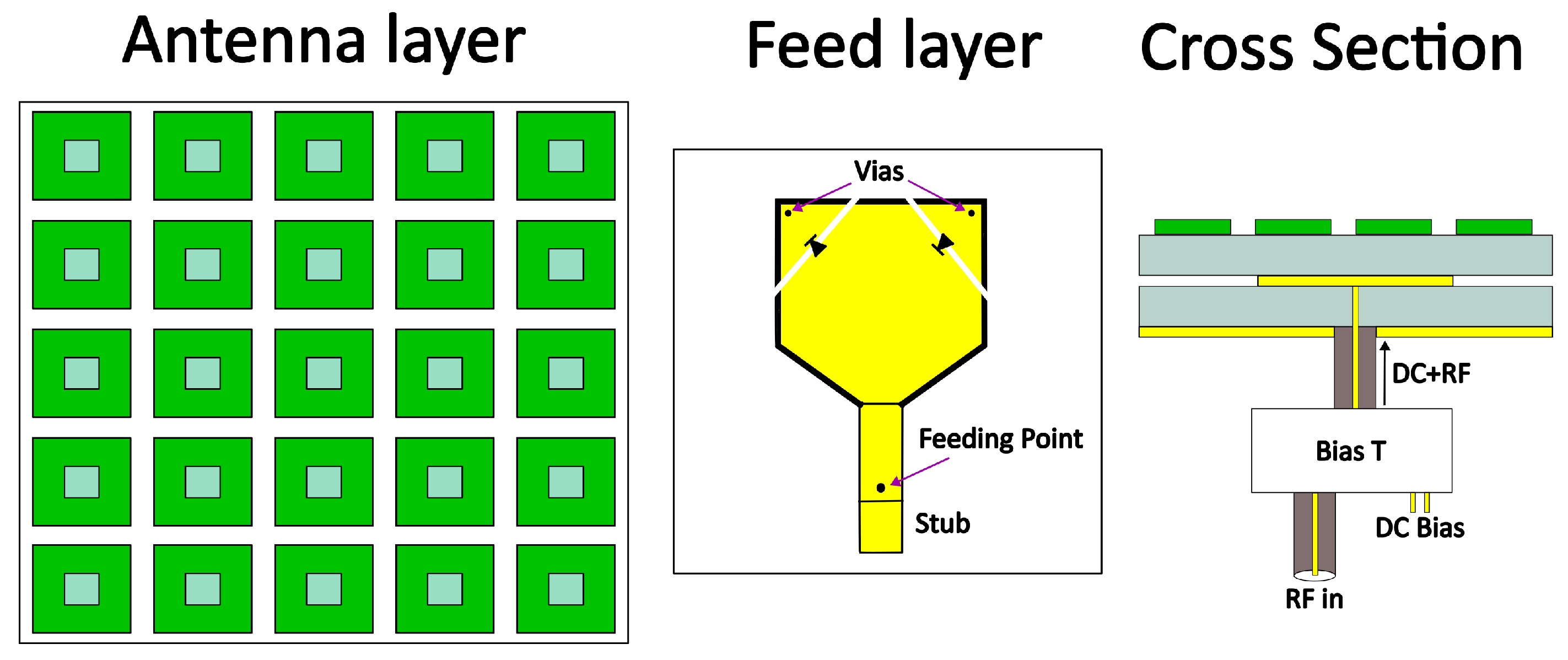
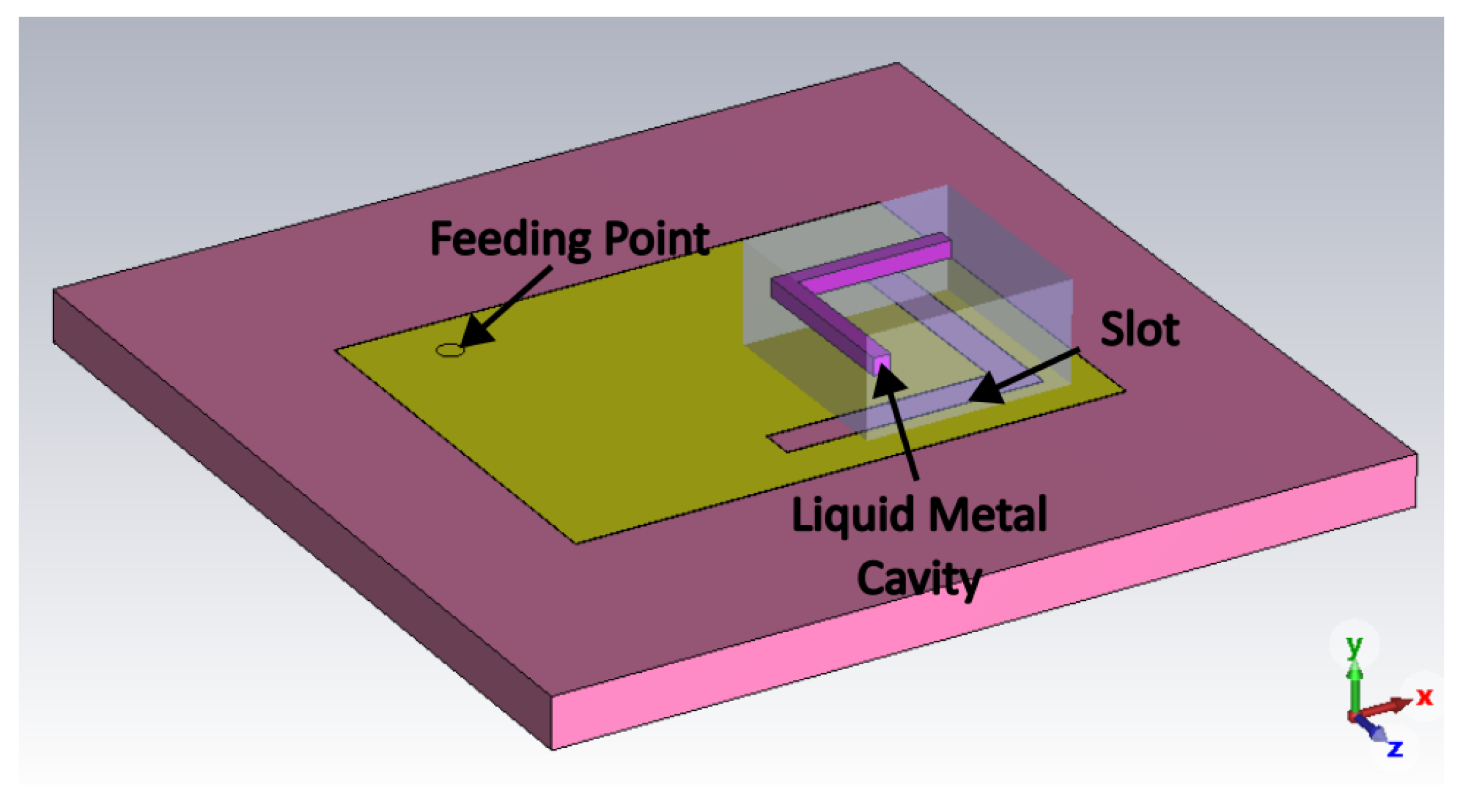
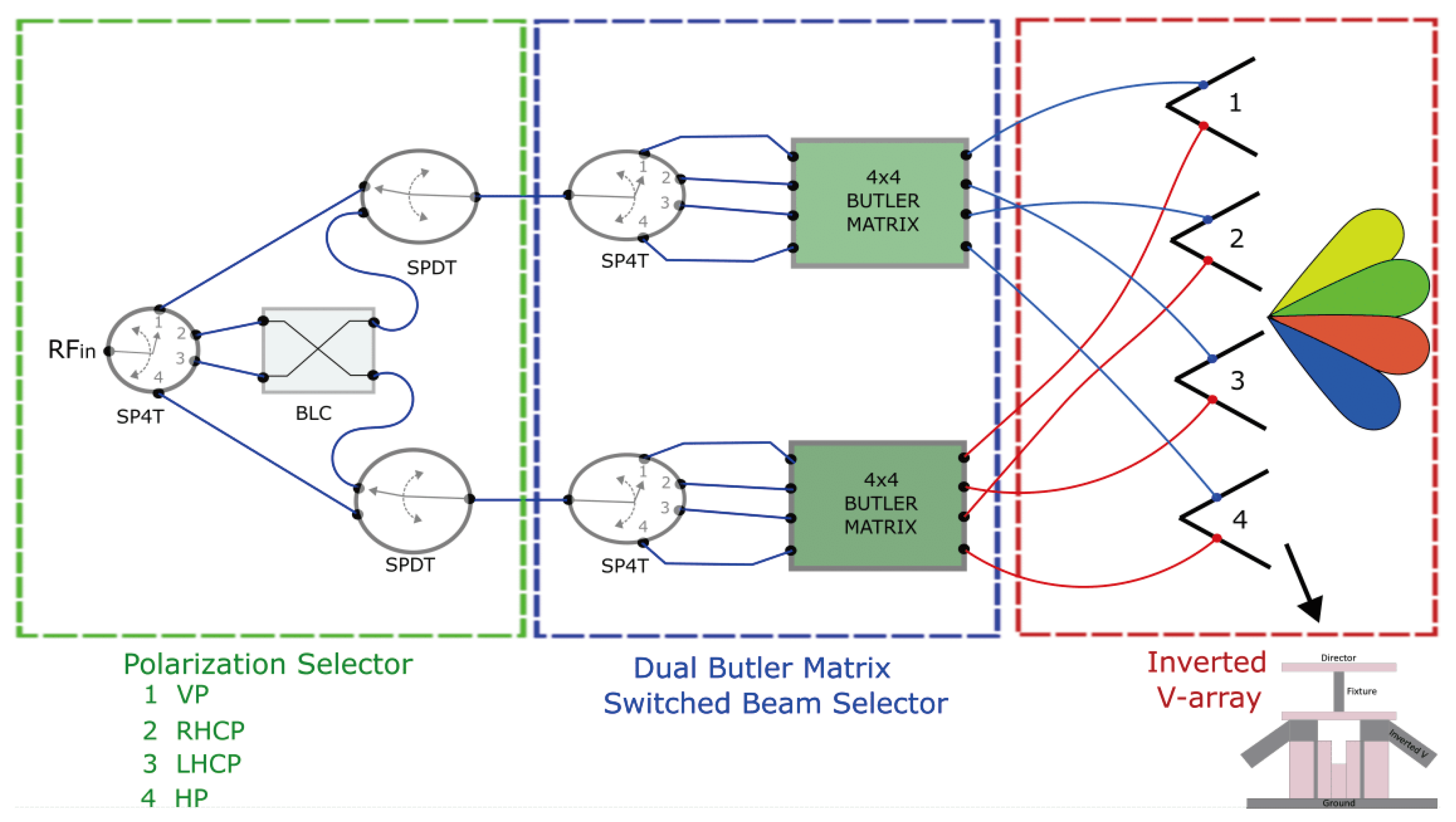
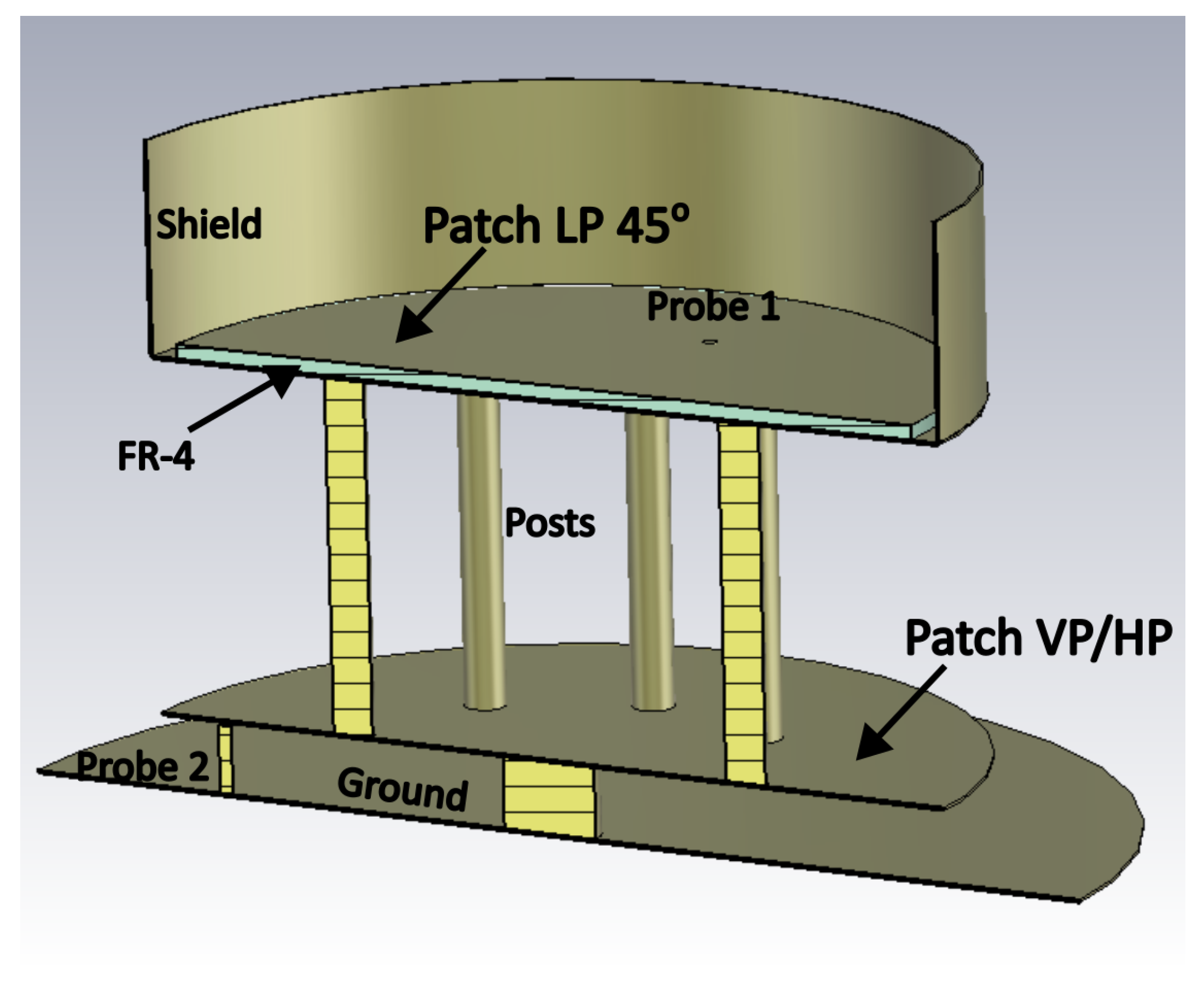

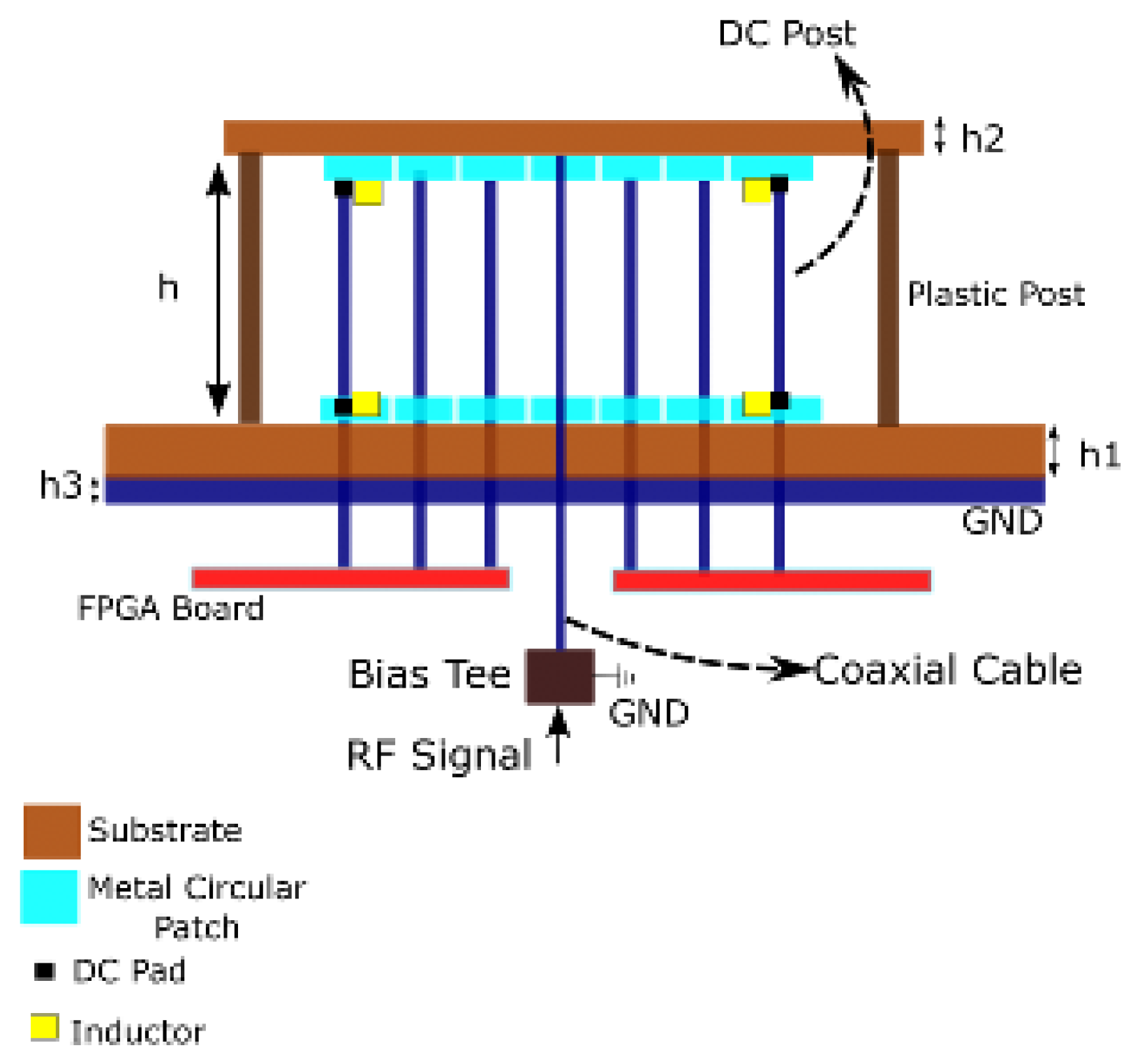
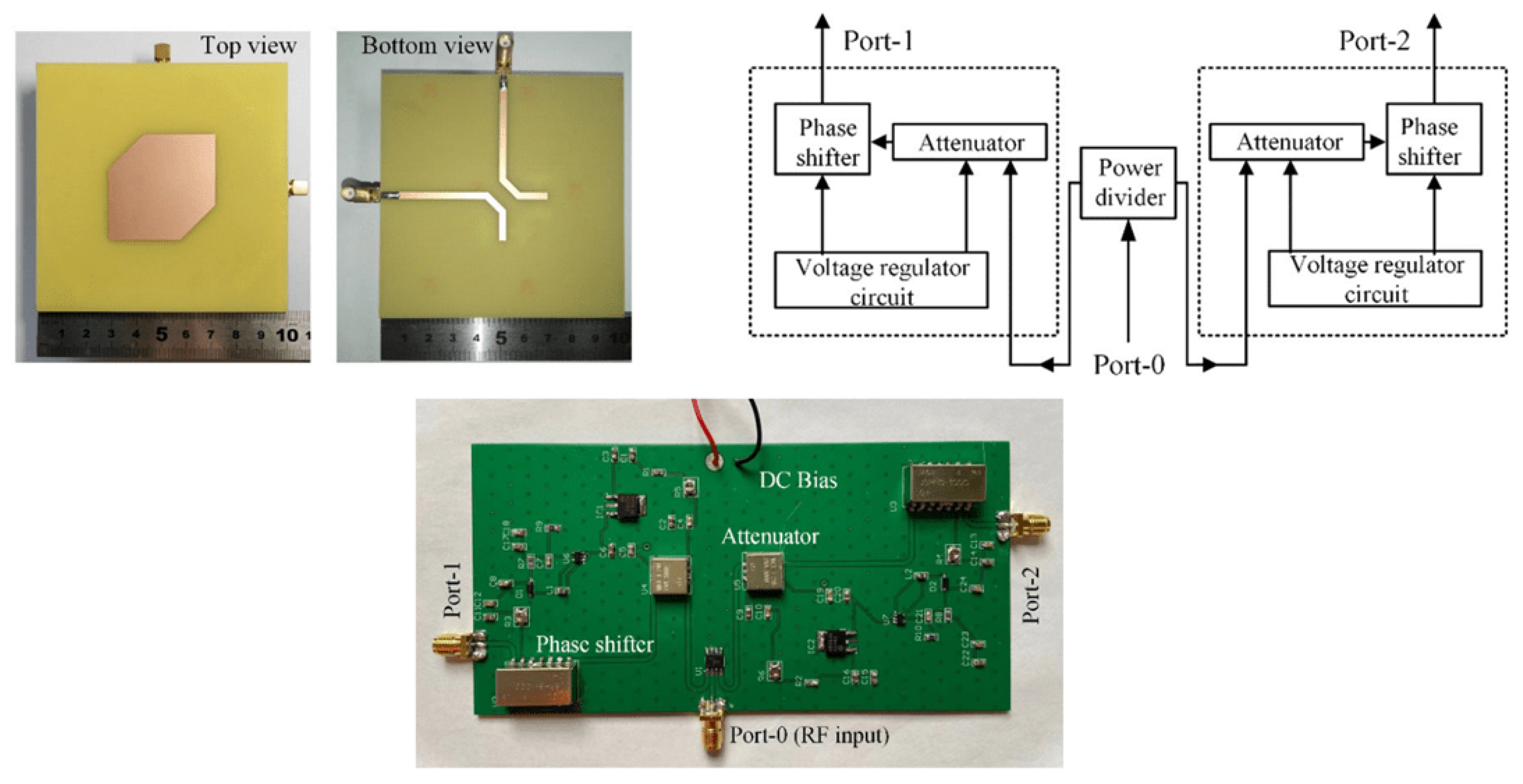
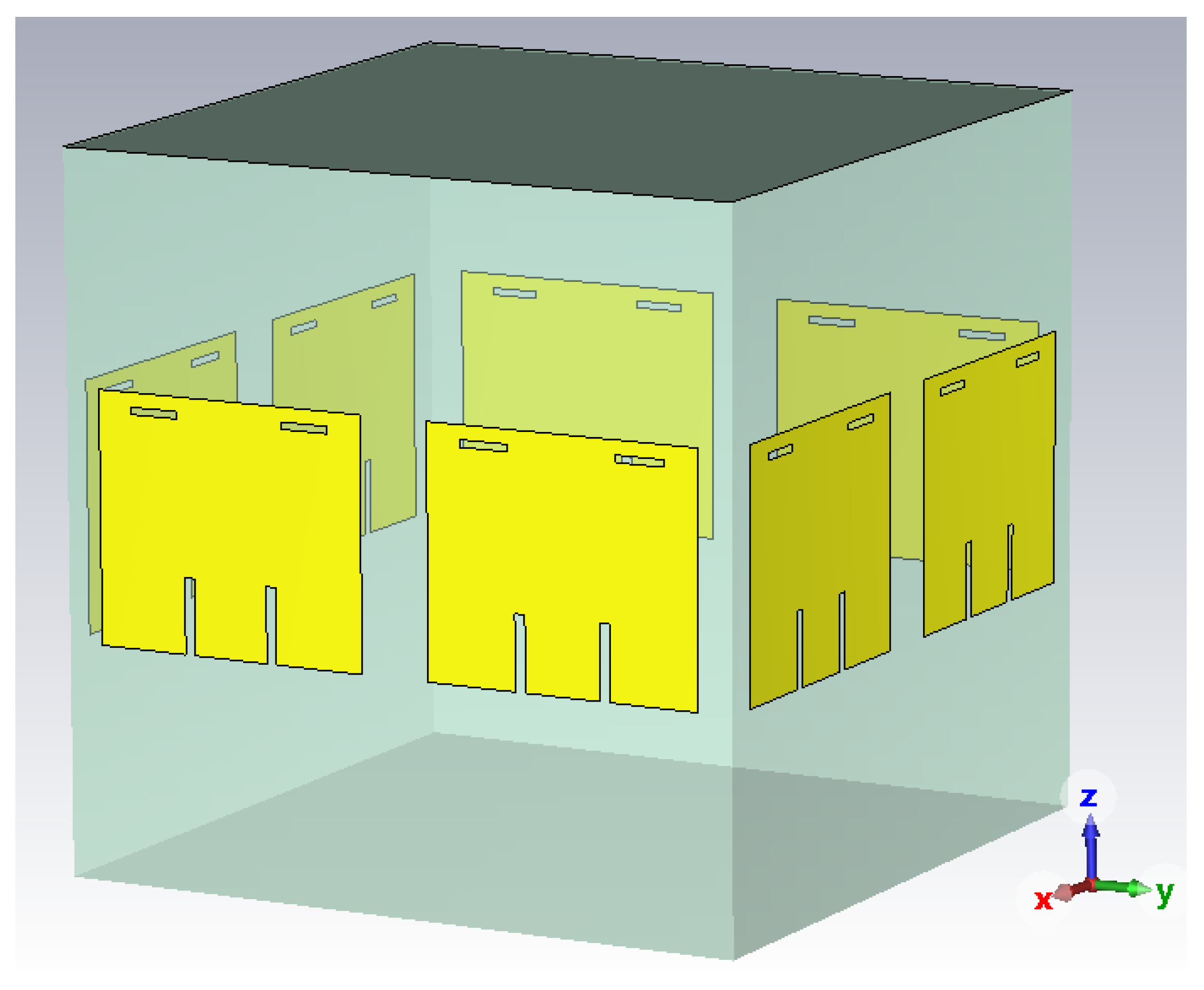



| Antenna | Gain (dBi) | Size (mm3) | Q | Frequency | Reference |
|---|---|---|---|---|---|
| Meandered Patch | −32.1/−31.5 | 5 × 5 × 0.635 | 4.05/6.45 | 1.4/2.45 GHz | [37] |
| Dif. Meandered Patch | −27.9 | 25 × 11 × 11 | 10 | 2.45 GHz | [18] |
| Impl. Vivaldi | −15.7 | 44 | 2 | 4 GHz | [42] |
| Rectangular Loop | −32 | 5 × 7 × 0.3 | 5.9 | 5.9 GHz | [34] |
| Meandered Patch | −28.65 | 6 × 9.55 × 0.2 | 5.21 | 2.4 GHz | [21] |
| Dif. Meandered Loop | −28.6 | 25 × 11 × 11 | 19.6 | 2.45 GHz | [36] |
| Diel. Resonator | −25.7 | 3 × 4.7 × 1 | - | 2.45 GHz | [19] |
| Metamaterial | −15.2 | 8 × 8 × 0.15 | - | 2.45 GHz | [41] |
| Conformal Loop | −28.9/−18.6 | 28 × 9 × 9 | - | 0.434/2.45 GHz | [29] |
| PIFA | −33.6/−21/−15.49/−10.25 | 154 | 3.19/2.25/8.33/14 | 0.403/0.915/1.4/2.45 GHz | [39] |
| PIFA | −45.6/−27.6/−25.4 | 11 × 20.5 × 1.8 | - | 0.403/0.902/2.45 GHz | [38] |
| ME | −18.1 | 0.2 × 0.05 × 0.001 | 632 | 2.53 GHz | [50] |
| ME Disc | −15.59 | 0.2 × 0.2 × 0.001 | 16 | 2.49 GHz | [51] |
| Self-biased ME | −61 | 3.5 × 5 × 0.025 | 1970 | 49.9 kHz | [46] |
| Antenna Type | Max Gain (dBi) | Size (cm2) | Rad. Pattern | Polar. (States) | Frequency | FBW (%) | Ref. |
|---|---|---|---|---|---|---|---|
| Ring Patch | 4.7 | 20.45 × 20.45 | Omnidirec. | LP(1) | 1.6 * GHz | 0.5/1 | [7] |
| Slotted Patch | 9.8 | 35 × 10.5 | Directive | LP(1), CP(2) | 2.4 GHz | 12.5 | [6] |
| Metasurface | 5.8 | 3.75 × 3.75 | Front Lobe | LP(1), CP(2) | 5.2 GHz | 12.4 | [66] |
| Windmill Metantenna | 5.25 | 4.8 × 4.8 | Front Lobe | LP(1), CP(2) | 3.65 GHz | 24.1 | [63] |
| Microfluid | 7.3 | 4 × 4 | Front Lobe | CP(2) | 4.6 * GHz | 5.2 | [67] |
| Crossed Inverted F | 12.8 | 18.5 × 15 | BF (−30°:30°) | LP(2), CP(2) | 5.8 GHz | 15.7 | [69] |
| Crossed Inverted F | 7.6 | 5.3 × 5.3 | Front Lobe | LP(4) | 3.4 GHz | 5 | [72] |
| High-Order Cavity | 25 | 10.4 × 10.4 | Directive | LP(4), CP(2) | 38.5 GHz | 13.3 | [73] |
| High-Order Cavity | 16.8 | 6.1 | Directive | LP(5) | 28.8 GHz | <0.1 | [74] |
| Crossed Bowtie Dipole | 6.6 | 9.5 × 9.5 | Front Lobe | LP(3), CP(2) | 2.7 GHz | 37.1 | [75] |
| Circular Sectored | 4.7 | 92.25 | Front Lobe | LP(16) | 2.2 * GHz | 35 | [76] |
| Truncated Patch | 6.8 | 10 × 10 | Directive | All | 2.45 GHz | 12.8 | [77] |
| Antenna Array | Max. Gain (dBi) | No. Beams | Angle Cover. | Polar. (No) | Freq. | FBW * (%) | Freq. Reconf. | Ref. |
|---|---|---|---|---|---|---|---|---|
| Cubical | 5.6 | 6 | 360° | LP(1) | 2.45 GHz | 2 | No | [9] |
| Planar | 15.28 | 12 | 60° | LP(3) | 1.8 GHz | 46 | Yes | [105] |
| Linear | 10.8 | Cont. | 120° | LP(2) | 27 GHz | 26 | Yes | [106] |
| Ortho-hexagonal | 10.8 | 5 | 100° | CP(2) | 2.58 GHz | 33 | Yes | [103] |
| Fan shaped | 3.9 | 4 | 360 ° | N/A | 2.4 GHz | 12.5 | No | [104] |
| Cylindrical | 4.29 | 14 | 6 | LP (1) | 2.44 GHz | 3 | No | [108] |
| ESPAR | 4.29 | 12 | 360° | LP (1) | 2.65 GHz | 1 | No | [107] |
| Slot ring | 7.6 | Cont. | 60° | LP(2), CP(2) | 6.65 GHz | 37 | No | [109] |
| -Dipole | 6.87 | Cont. | 60° | ALL | 2.5 GHz | 9.6 | No | [56] |
| Annular | 4.62 | Cont. | 60°/90° | LP (3), CP(2) | 4.16 GHz | <1 | No | [110] |
Disclaimer/Publisher’s Note: The statements, opinions and data contained in all publications are solely those of the individual author(s) and contributor(s) and not of MDPI and/or the editor(s). MDPI and/or the editor(s) disclaim responsibility for any injury to people or property resulting from any ideas, methods, instructions or products referred to in the content. |
© 2024 by the authors. Licensee MDPI, Basel, Switzerland. This article is an open access article distributed under the terms and conditions of the Creative Commons Attribution (CC BY) license (https://creativecommons.org/licenses/by/4.0/).
Share and Cite
Arnaoutoglou, D.G.; Empliouk, T.M.; Kaifas, T.N.F.; Chryssomallis, M.T.; Kyriacou, G. A Review of Multifunctional Antenna Designs for Internet of Things. Electronics 2024, 13, 3200. https://doi.org/10.3390/electronics13163200
Arnaoutoglou DG, Empliouk TM, Kaifas TNF, Chryssomallis MT, Kyriacou G. A Review of Multifunctional Antenna Designs for Internet of Things. Electronics. 2024; 13(16):3200. https://doi.org/10.3390/electronics13163200
Chicago/Turabian StyleArnaoutoglou, Dimitrios G., Tzichat M. Empliouk, Theodoros N. F. Kaifas, Michael T. Chryssomallis, and George Kyriacou. 2024. "A Review of Multifunctional Antenna Designs for Internet of Things" Electronics 13, no. 16: 3200. https://doi.org/10.3390/electronics13163200







